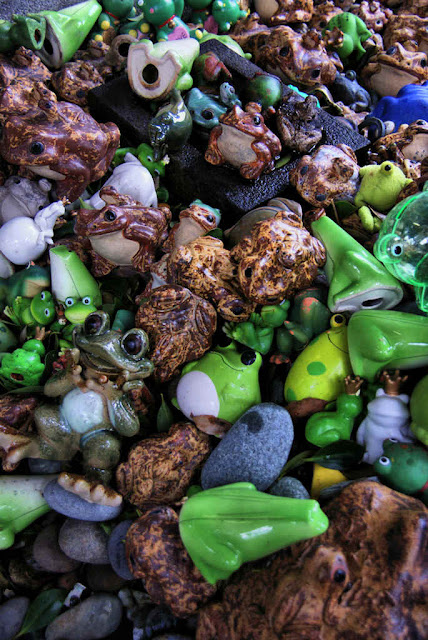Popular shrines will often have large numbers of objects left or donated by worshippers who either are praying for something, or giving thanks for something. Votive tablets, known as ema in Japanese, or even simple wooden torii gates like those found at many Inari shrines are common, as is leaving miniature statues.
At Omiroikusama Shrine in Tosa, Kochi you will find lots of ema, lots of torii, and literally thousands and thousands of miniature frogs.
Frog statues and figurines can be seen at quite a few temples. The word for frog, kaeru, also means "return" and so is often used a symbol meaning safe return. Such homophones are quite common in Japan as the Japanese language is composed of relatively few sounds.
However the frogs here have nothing to do with returning, rather the frogs skin reminds people of warts, and at Omiroku Shrine the tradition is that you pray here for relief from warts, and if successful then you come back and leave a small frog.
The fame of Omirokusama Shrine has spread and people from all over Japan make the journey to Shikoku to pray at the shrine and nowadays a new twist has been added as the idea that cancer is a form of internal warts has taken hold.
The origin of the shrine lies in 1899 when a local farmer dug up a sacred object of some kind. Most sources say a"shrine", but it is not clear exactly what that means.
He took it home and placed it in his storehouse. Later he and his family became plagued with warts and other skin ailments. He consulted a Shinto priest who told him the kami was upset at being moved and the man should return the "shrine" to its original spot.
This he did, and so the shrine began. The rest, as they say, is history. Incidentally, Miroku is the Japanese name for Maitreya, a Buddhist bodhisattva known as the Future Buddha.
Though tiny, this is a fascinating site to visit. Very much a creation of "folk" and having nothing to do with imperial shinto, the influence of Buddhism is also very "folk".







































































